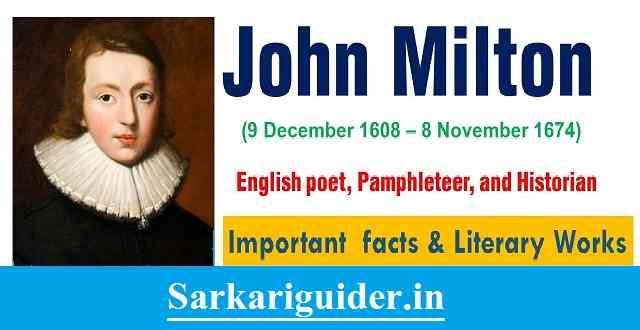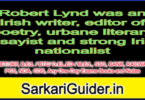John Milton

John Milton Biography
John Milton Life and Works –
John Milton was born on December 9, 1608, at the Sign of the spread Eagle (his father’s house), in Bread Street, Cheapside. His father, John Milton the elder, was a scrivener and composer of music. He took education at St. Paul’s School, where he formed friendship with Diodati, then at Christ’s College, Cambridge, where his handsome personality won him the nickname the Lady of Christ’s. He was briefly rusticated in 1626. He did his B.A. in 1629 and M.A. in 1632. While at Cambridge, he began to write poetry in Latin, Italian and in English on themes, sacred and secular. His first attempt at English verse “On the Death of a Fair Infant”, (1628) wa an elegy on the death of his niece Anne Phillips. His first distinctively Miltonic work, ‘On the Morning of Christs Nativity’, was written at Christmas 1629. His twin poems ‘L’ Allegro and 11 Penseroso were writen in 1631-32. On leaving Cambridge, Milton adopted no profession. Instead, he studied privately in preparation for a future as poet or clergyman. His masque, Comus, was written and performed at Ludlow in 1634. His Lycidas (1637), a pastoral elegy on the death of Edward King, contemplates on fears of premature death, unfulfilled ambition, and
wasted dedication.
During the period of the publication of Lycidas and the composition of Paradise Lost, Milton wrote no poetry, except for some Latin and Italian pieces, and some sonnets. Some of his notable sonnets are those ‘On the late Massacre in Piedmont’, ‘On His Blindness’, ‘On His Deceased Wife’ etc. In June 1642 Milton married Mary Powell, daughter of royalist parents. He was then 33 and she 17. Within six weeks she went her home not to return soon, and this provoked Milton to write the Doctrine and Discipline of Divorce in 1643, which brought him notoriety. In 1644 appeared ‘Of Education’ (addressed to his friend Hartlib) and ‘Areopagitica’; a great defence of the liberty of the press. It was now that he became aware of his growing blindness. By 1651 he became totally blind. His wife returned to him in 1645. He had two daughters and a son from her, but the last of which died in infancy.
After the execution of Charles I, Milton published ‘The Tenure of Kings and Magistrates’ (1649) advocating people’s right to depose and punish tyrants, and attacking the Presbyterians, who were a growing threat to freedom. His wife died in 1652. In 1656 he married Katherine Woodcock, who also died after two years. At The Restoration he was arrested, fined and released. He now started the composition of his greatest work ‘Paradise Lost’. In 1663 he married his third wife, Elizabeth Minshull, who outlived her husband. ‘Paradise Lost’ was finished by 1663, but could not be published until 1667, because the agreement for his copyright was not signed until then. His ‘Paradise Regained’ and ‘Samson Agonistes’ were published in 1671. Sudden attack of gout claimed his lie in 1674 and he was buried beside his father in St. Giles’ Cripple gate.
Dryden praised his ‘Paradise Lost’ describing it as one of the greatest, most noble and sublime poems which either this age or nation has produced’. Commenting on Milton’s unrecognised greatness in his life time, Compton Rickett writes, “Perhaps no great poet was ever accounted so little by his own generation as Milton. But his greatness was not for long undiscovered.”
In his literary percentage, Milton owes a little both to Donne and Spenser. However, he has left behind a rich legacy to English poetry. Milton gave English poetry its quality of greatness and splendour. His epic genius has found its complete and perfect expression in the Biblical story of the fall of man, Consequently, in the last years of his life, Milton wrote “Paradise lost”, “Paradise Regained” and “Samson Agonistes”.
Even in his early poems : “L’Allegro”, Penseroso”, “Comus” and “Lycidas” we observe a great sense of beauty. hese poems have all the freshness and charm of youth. They show the lighter and more fanciful side of Milton’s genius. Milton’s sense of beauty also combines with it a statliness of manner which gives a high and glorious dignity to his poetry.
Milton’s prose work is characterised by uncompromising directness and passionate vehemence. His avowed object had always been “to write plainly and roundly”. Milton’s last pamphlet differs from the preceding ones on account of the method which is discursive and speculative. His passion for independence is well displayed in the pamphletes. His best known “Areopagitica”, published in the year 1644, was cast in the form of a speech addressed to the parliament. This was a speech for the liberty of unlicensed printing.
Milton’s Greatness as a poet and writer lies in his loftiness of thought, splendid dignity of expression and rhythmic felicities. In this respect, Milton has few peers, no superior. The matter of his work may be limited in its interest and significance, but there has been no finer exponent of the “grand manner”.
Milton was one of the greatest poets of England. He is placed next to Shakespeare in the hierarchy of English poets. His works can be divided into the following three periods.
The First Period: (1629-1640):
This is the period of Milton’s university career and his study at Horton. During this Horton period, Milton composed, “Ode on the Morning of Christ’s Nativity (1629) “L’Allegro”,”11 Pensseroso”, “Comus” and “lycidas”. He also composed “On Shakespeare” (1630), and “On Arriving at the age of twenty three” (1631).
The Second Period (1640-63):
It is chiefly Milton’s period of political work and prose writings. Alongwith many prose pamphlets and the famous “Areopagitica” (1644). Milton also composed his eighteen sonnets such as “On His Blindness” and “On The Late Massacre in Piedmont” etc.
The Third Period (1660-74):
It is the period of the great poems of Milton during this period Milton produced “Paradise Lost” (1667), “Paradise Regained” (1671) and “Samson Agonistes” (1671).
Important links
Metaphysical Poetry: Definition, Characteristics and John Donne as a Metaphysical Poet
John Donne as a Metaphysical Poet
Shakespeare’s Sonnet 116: (explained in hindi)
What is poetry? What are its main characteristics?
Debate- Meaning, Advantage & Limitations of Debate
Sarojini Naidu (1879-1949) Biography, Quotes, & Poem Indian Weavers
Charles Mackay: Poems Sympathy, summary & Quotes – Biography
William Shakespeare – Quotes, Plays & Wife – Biography
Ralph Waldo Emerson – Poems, Quotes & Books- Biography
What is a lyric and what are its main forms?






